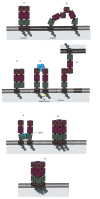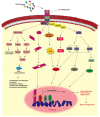RAGE Signaling in Melanoma Tumors
- PMID: 33256110
- PMCID: PMC7730603
- DOI: 10.3390/ijms21238989
RAGE Signaling in Melanoma Tumors
Abstract
Despite recent progresses in its treatment, malignant cutaneous melanoma remains a cancer with very poor prognosis. Emerging evidences suggest that the receptor for advance glycation end products (RAGE) plays a key role in melanoma progression through its activation in both cancer and stromal cells. In tumors, RAGE activation is fueled by numerous ligands, S100B and HMGB1 being the most notable, but the role of many other ligands is not well understood and should not be underappreciated. Here, we provide a review of the current role of RAGE in melanoma and conclude that targeting RAGE in melanoma could be an approach to improve the outcomes of melanoma patients.
Keywords: HMGB1; RAGE; S100 proteins; inflammation; melanoma; melanomagenesis; receptor for advanced glycation end products; tumorigenesis.
Conflict of interest statement
The authors declare no conflict of interest.
Figures



Similar articles
-
Ousting RAGE in melanoma: A viable therapeutic target?Semin Cancer Biol. 2018 Apr;49:20-28. doi: 10.1016/j.semcancer.2017.10.008. Epub 2017 Oct 24. Semin Cancer Biol. 2018. PMID: 29079306 Free PMC article. Review.
-
AGEs, RAGEs and s-RAGE; friend or foe for cancer.Semin Cancer Biol. 2018 Apr;49:44-55. doi: 10.1016/j.semcancer.2017.07.001. Epub 2017 Jul 13. Semin Cancer Biol. 2018. PMID: 28712719 Review.
-
RAGE and its ligands: from pathogenesis to therapeutics.Crit Rev Biochem Mol Biol. 2020 Dec;55(6):555-575. doi: 10.1080/10409238.2020.1819194. Epub 2020 Sep 16. Crit Rev Biochem Mol Biol. 2020. PMID: 32933340
-
Glycation reaction and the role of the receptor for advanced glycation end-products in immunity and social behavior.Glycoconj J. 2021 Jun;38(3):303-310. doi: 10.1007/s10719-020-09956-6. Epub 2020 Oct 27. Glycoconj J. 2021. PMID: 33108607 Review.
-
Role of the Receptor for Advanced Glycation End Products (RAGE) and Its Ligands in Inflammatory Responses.Biomolecules. 2024 Dec 4;14(12):1550. doi: 10.3390/biom14121550. Biomolecules. 2024. PMID: 39766257 Free PMC article. Review.
Cited by
-
Nutritional Interventions for Patients with Melanoma: From Prevention to Therapy-An Update.Nutrients. 2021 Nov 11;13(11):4018. doi: 10.3390/nu13114018. Nutrients. 2021. PMID: 34836273 Free PMC article. Review.
-
Primary tumour category, site of metastasis, and baseline serum S100B and LDH are independent prognostic factors for survival in metastatic melanoma patients treated with anti-PD-1.Front Oncol. 2023 Aug 17;13:1237643. doi: 10.3389/fonc.2023.1237643. eCollection 2023. Front Oncol. 2023. PMID: 37664072 Free PMC article.
-
Preclinical Study of Immunological Isoxazole Derivatives as a Potential Support for Melanoma Chemotherapy.Int J Mol Sci. 2021 Oct 10;22(20):10920. doi: 10.3390/ijms222010920. Int J Mol Sci. 2021. PMID: 34681580 Free PMC article.
-
Efferocytosis by macrophages in physiological and pathological conditions: regulatory pathways and molecular mechanisms.Front Immunol. 2024 May 8;15:1275203. doi: 10.3389/fimmu.2024.1275203. eCollection 2024. Front Immunol. 2024. PMID: 38779685 Free PMC article. Review.
-
Attacking Cancer Progression and Metastasis.Int J Mol Sci. 2023 Apr 26;24(9):7858. doi: 10.3390/ijms24097858. Int J Mol Sci. 2023. PMID: 37175564 Free PMC article.
References
-
- Howlader N., Noone A.M., Krapcho M., Miller D., Brest A., Yu M., Ruhl J., Tatalovich Z., Mariotto A., Lewis D.R., et al. SEER Cancer Statistics Review, 1975–2017. National Cancer Institute; Rockville, MD, USA: 2020.
Publication types
MeSH terms
Substances
Grants and funding
LinkOut - more resources
Full Text Sources
Medical
Miscellaneous

